Published: 16 Dec 2021
Exploratory Testing: A Detailed Guide
Last Updated: 21 Jun 2022
Today, every business needs robust, scalable, and high-quality software to deliver a great customer experience (CX). Typically, any undetected bugs in the software can cost businesses in terms of customer experience, brand reputation, and business value. This is the reason why businesses ensure end-to-end testing of their software before releasing it in the market. There are various types of software testing methods that are performed to check the functional and non-functional aspects of the software. While some of these tests are well-planned in advance, such as functional, regression, automation testing, to name a few, some tests like exploratory testing are entirely unplanned and are performed by software testers on the fly.
Content
1. What is exploratory testing?
2. Different types of exploratory testing
3. When should businesses take up exploratory testing?
4. Major differences between exploratory testing and scripted testing
5. Major differences between ad-hoc testing and exploratory testing
6. How does exploratory testing fit in an agile environment?
7. Two major approaches of exploratory testing
8. 7 Step process of exploratory testing
9. How to overcome challenges faced by testers during exploratory testing?
10. Can exploratory testing be automated?
11. Exploratory testing tools
What is exploratory testing?

Exploratory testing is an effective software testing approach wherein testers navigate through the software without any specific aim in mind. In this testing method, testers check the app/website on the fly to identify and document potential bugs. Unlike traditional software testing methods, testers do not work on previously created test cases while performing this testing method.
The basic idea behind this special testing technique is to let testers mimic individual end-users’ personal freedom and choices. Hence, in this process, testers explore the software to understand the product’s quality and user experience. It involves minimal planning as testers spontaneously decide what features and actions to test, thus reflecting the individual interests of end-users. According to James Bach, “Exploratory testing is simultaneous learning, test design, and test execution.”
Different types of exploratory testing
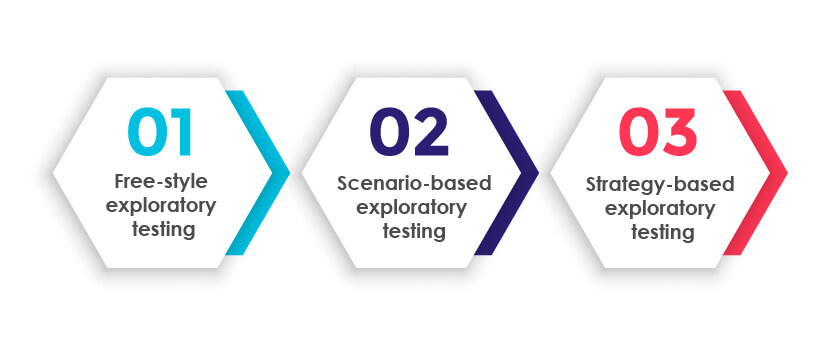
Free-style exploratory testing:
This type of testing follows a free-style approach to testing and does not include any rules, approaches, or specifications. Simply testers go through the application quickly, mainly to identify defects, verify the work of other testers, or even perform a quick smoke test.
Scenario-based exploratory testing:
This form of testing is based on real-user scenarios wherein testers take each scenario and then test the software from all angles to match the scenario. The main aim of this testing type is to explore the software for maximum possible scenarios and ensure to increase the test coverage.
Strategy-based exploratory testing:
This type of testing is performed by an experienced tester who has complete knowledge of the software under test. It involves various testing techniques such as boundary value analysis, equivalence, risk-based, error guessing, etc., to identify more challenging bugs.
Why should businesses leverage exploratory testing?
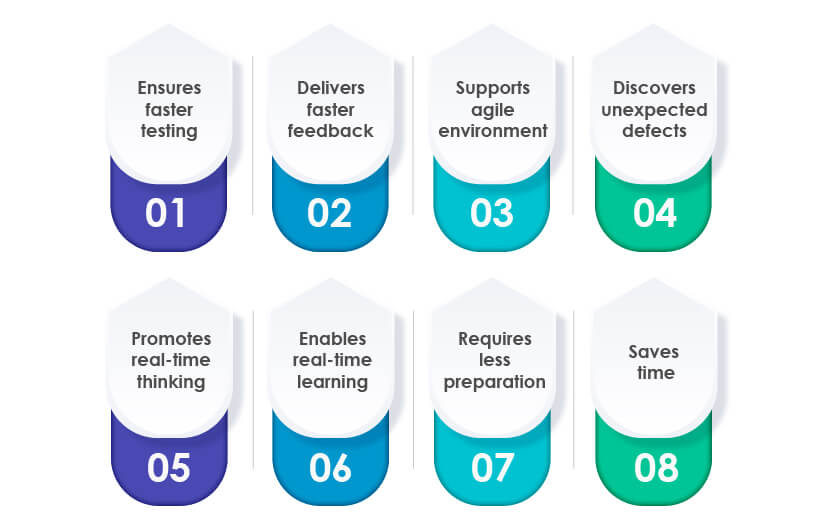
1. Ensures faster testing:
This testing method requires less preparation as it does not require any predefined test plans, which means testers can start testing early and at a quicker pace.
2. Delivers faster feedback:
Testers perform this testing process on the fly, enabling speedier feedback.
3. Supports agile environment:
This special testing type can be performed in an agile environment as it allows changes in requirements with faster feedback.
4. Discovers unexpected defects:
This testing method helps in finding unexpected defects or behavior that remain unidentified during other testing methods.
5. Promotes real-time thinking:
Exploratory testing brings in the human approach to software testing as testers explore the app from various angles using real-time thinking and human intelligence.
6. Enables real-time learning:
This testing method allows testers to learn and test the software simultaneously. Thus, testers with less product knowledge can also perform this test to learn about the software while testing it.
7. Requires less preparation:
This testing method does not require much preparation or documentation before starting the test. Thus, testers can start testing quickly.
8. Saves time:
This testing technique takes less time than other methods and allows quick decisions, ultimately saving testers and stakeholders time.
When should businesses take up exploratory testing?

• Initially, while writing test cases for new features or new products
• There is a need to learn about an application quickly
• Quick feedback about a product is needed
• The test coverage is to be increased
• There is a need to identify a single most important bug in less time
• The software has already been tested using scripted test methods
• In situations where there is a need to diversify the testing process
•
Major differences between exploratory testing and scripted testing
| Scripted Testing |
Exploratory Testing |
| Testers follow the sequence and steps of test cases which are predefined |
There are no predefined steps or sequence of test cases. Testers test the software on the fly. |
| Feedback is slower |
Enables rapid feedback |
| Test scripts can be traced back to original requirements to check the test coverage |
There is no such traceability for test coverage in this testing type |
| Testers test the application based on the specifications |
Testers test the application based on their understanding, creativity, expectations. |
| Tests can be reproduced in this testing type |
Tests may not be reproduced in this testing type |
Major differences between ad-hoc testing and exploratory testing
| Adhoc Testing |
Exploratory Testing |
| It implies learning the software before testing |
It implies simultaneous learning and testing the software |
| There is no time limit to perform this test |
It has a time limit and follows a time-boxed session approach |
| It can be used for simple functions that may not require much documentation, such as registration, login, etc. |
It can be used for complex functions where little documentation is required |
| Testers should have prior knowledge of the app |
A tester doesn’t need to have any prior knowledge of the app as the tester can learn about the app while testing |
| It follows a less practical approach to testing |
It follows comparatively a more practical approach to testing |
How does exploratory testing fit in an agile environment?

The main aim of agile methodology is to deliver high-quality products quickly. Also, since there are shorter sprints in an agile environment, the need for a faster testing process is high, where exploratory testing fits in the agile environment.
In exploratory testing, the software is tested quickly on the go. Testers have complete freedom to explore the product from all perspectives using their creative thinking and intelligence. This testing method helps in finding the bugs and edge cases that were overlooked during other testing methods. Since this testing type allows testers to learn and test the product simultaneously, it allows them to provide rapid feedback, which is essential in an agile environment. Also, as the project progresses, the scope of requirements widens, developers and testers often have to work on new features or functionalities. This testing technique is useful in agile scenarios, as testers can quickly test newly added features and react to changes effectively without modifying the entire test plan.
Thus, if one looks carefully at the
| Agile Principles |
Exploratory testing justifying agile principles |
| One of the agile principles states to deliver working software frequently from a couple of weeks to a couple of months, with a preference for the shorter timescale. |
This testing type allows testers to test the software rapidly. It is extremely useful for situations where timelines are short. Thus, by leveraging exploratory testing, businesses can deliver quality software faster. |
| Another agile principle states to satisfy the customer through early and continuous delivery of valuable software. |
Exploratory testing combined with automation testing in an agile environment can yield early and continuous delivery of high-quality software. |
| Further, another agile principle states it is important to respond to changes quickly and accept changes in requirements even late in the development stage. |
This special testing method allows testers to quickly test newly added features or functionalities even if they are added late in the project. Thus, it allows teams to react to changes spontaneously. |
Two major approaches of exploratory testing
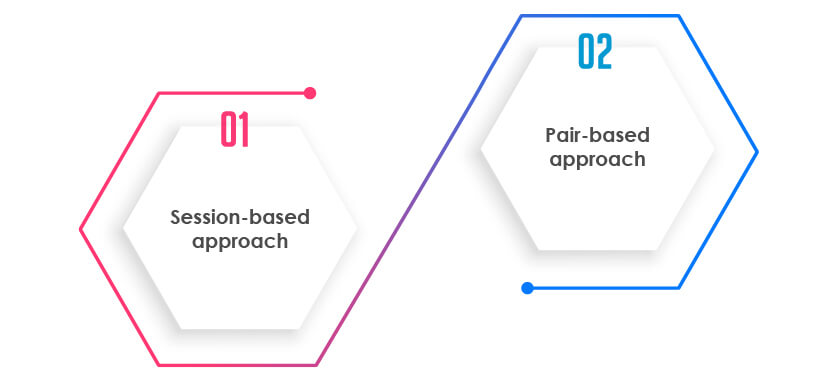
Session-based approach: A time-based approach to software testing includes a dedicated time-boxed testing session. There are two pre-conditions of this testing method, i.e., duration of the session (45 minutes to 90 minutes), and the objective of the testing, commonly known as charter.
Pair-based approach: In this approach, two people test the same feature of the application by sharing a computer. They work in a pair and continuously share thoughts or ideas.
7 Step process of exploratory testing
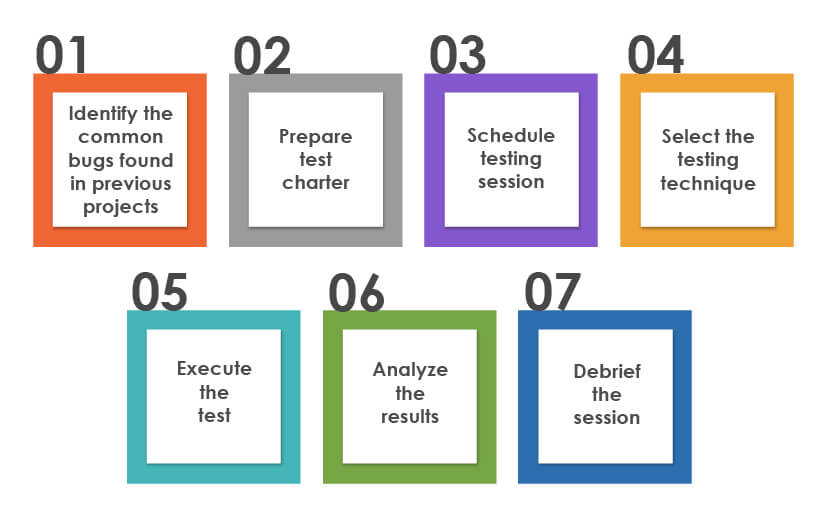
1. Identify the common bugs found in previous projects:
Before starting the testing process, it is essential to identify the common type of bugs found in previous projects. Testers should find the root cause of those bugs and must identify the risky areas that need to be covered in the project while testing.
2. Prepare test charter:
It is an important document that must be prepared to keep the testing process on track. The charter clearly outlines the aim of the test, areas or features that are to be tested, how those areas will be tested, and important metrics to be kept in mind while testing.
3. Schedule testing session:
Next step involves scheduling the testing session where the time-boxed approach is used. The time limits are set to let testers know when to stop. This time session generally lasts for a maximum of 90 minutes. It is advised to keep this session without interruptions and be extended if required.
4. Select the testing technique:
There are various techniques to perform this testing type, and testers should select the best suitable testing technique based on the testing needs, resource availability, convenience, etc.
5. Execute the test:
The crucial step is to execute the test without interruptions and aim for the maximum test coverage to find the maximum defects.
6. Analyze the results:
Once the test is complete, testers review the results and document them for future reference.
7. Debrief the session:
This is the last step of the testing process wherein testers compile test results, compare actual test results with expected test results, and decide whether additional testing is required or not.
How to overcome challenges faced by testers during exploratory testing?
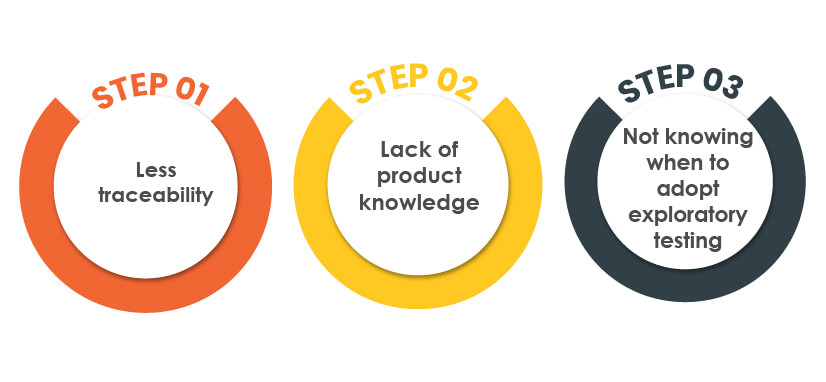
Less traceability:
In this testing methodology, testers do not follow any predefined test plan, test strategy, or test scripts. Also, its documentation is progressive. Hence, it lacks traceability which acts as a challenge. To overcome this challenge, testers should log the test as and when it is executed. Also, the test progress should be shared with stakeholders or fellow testers to keep them informed.
Lack of product knowledge:
This testing type can be performed by individuals who lack product knowledge, but sometimes this can act as a challenge. Without a proper understanding of the product, there is every possibility of missing some important scenarios. Hence, in order to overcome this challenge, it is advised to include skilled testers in the testing team to perform this test. It is effective to leverage pair testing, where both testers should be highly skilled, or either one of them should be skilled.
Not knowing when to adopt exploratory testing:
Another challenge in this testing methodology is that sometimes businesses don’t know the right time to adopt and implement it. Since this testing method lacks test cases and is a bit informal, it is not considered good for auditing purposes. Therefore, if implemented at the wrong time, it can have a negative impact. To overcome this challenge, businesses should leverage this test method to find out bugs in the software when time is less. Once the bugs are fixed, this testing method can be used to verify those bugs on the fly. It should not be used for projects that need more This special testing method is performed manually to a large extent, and its effectiveness depends upon human intelligence. But, as businesses continue to leverage test automation, there is always a question about whether it can be automated or not when it comes to exploratory testing.
Can exploratory testing be automated?
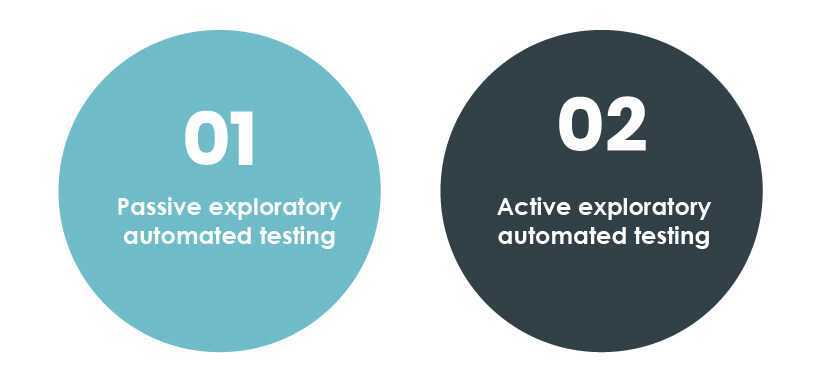
Yes, exploratory testing can be automated to a certain extent. It can be combined with test automation methods to help better bug reproduction, regression test execution, evidence gathering, etc. There are two types of automated exploratory testing methods:
Passive exploratory automated testing:
In this testing method, special video recording tools are installed on the tester’s system/computer to record their actions while testing. During this testing method, at the end of the testing session, an additional task is added for designing the test results based on the recorded session for creating test reports. Video recording tools are used to record this testing process which helps testers save time consumed in preparing test reports.
Active exploratory automated testing:
This method integrates the Keyword Driven Testing approach with the session execution and it is used in pair testing, wherein one tester creates automated test scripts, and the other tester executes the test scripts.
Exploratory testing tools
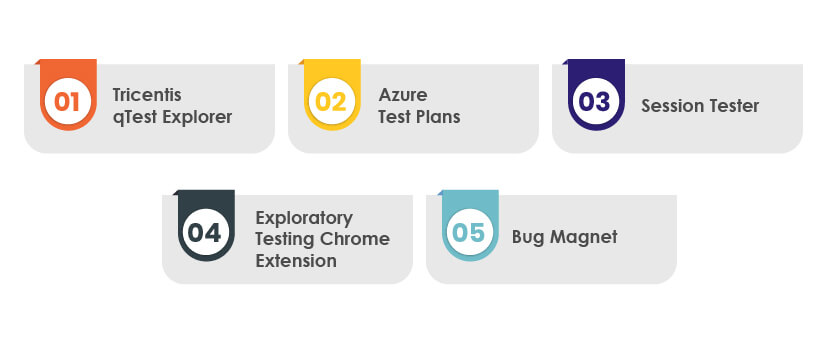
1. Tricentis qTest Explorer:
This tool is an easy-to-use software testing tool that simplifies scripted and unscripted testing. It can be used to capture mouse clicks, field change, page change, etc. This testing tool can track all interactions during the testing process and automatically creates defect documentation. Testers can easily submit detailed defect documentation to Jira by leveraging this tool, which instantly turns test sessions into reusable automated test scripts.
2. Azure Test Plans:
It is a widely used tool that helps to improve code quality. This tool can be used to capture rich scenario data, test applications across desktop or web apps, and ensure end-to-end traceability of tests.
3. Session Tester:
This tool is used for managing and recording session-based testing. It contains a timer that can set the time limit of test sessions to a particular length. This testing tool allows easy recording of session notes. These session notes are stored in XML format and can easily be converted to other formats.
4. Exploratory Testing Chrome Extension:
It is a chrome extension that is used for web exploratory testing. This extension can be used to report bugs, take notes, capture screenshots during the session, and more. This testing tool can easily summarize session reports that can be saved and imported if required.
5. Bug Magnet:
An open-source extension for Chrome and Firefox allows easy access to common boundaries and edge cases. This tool works on input fields, text areas, content editable DIVs. Testers can inject values using JavaScript or clipboard events to simulate user workflows using this tool.
Conclusion
Exploratory testing is a practical approach to software testing that saves time and brings human intelligence, critical reasoning, and analytical skills to best use. It is mostly used in an agile environment where timelines are short, and teams are expected to deliver high-quality products faster. While this testing method completely depends on the tester’s intelligence and experience, it can be combined with test automation techniques using various automated testing tools to enhance testing efficiency. Businesses should leverage exploratory testing from a next-gen QA and independent software testing services provider for faster quality software releases and to provide a great experience to customers.